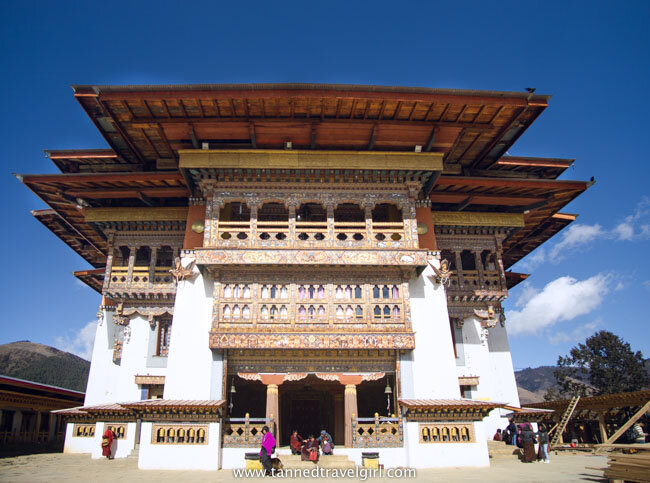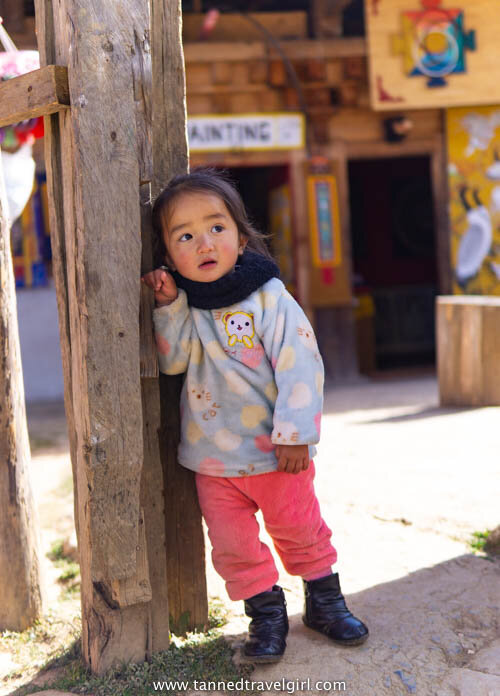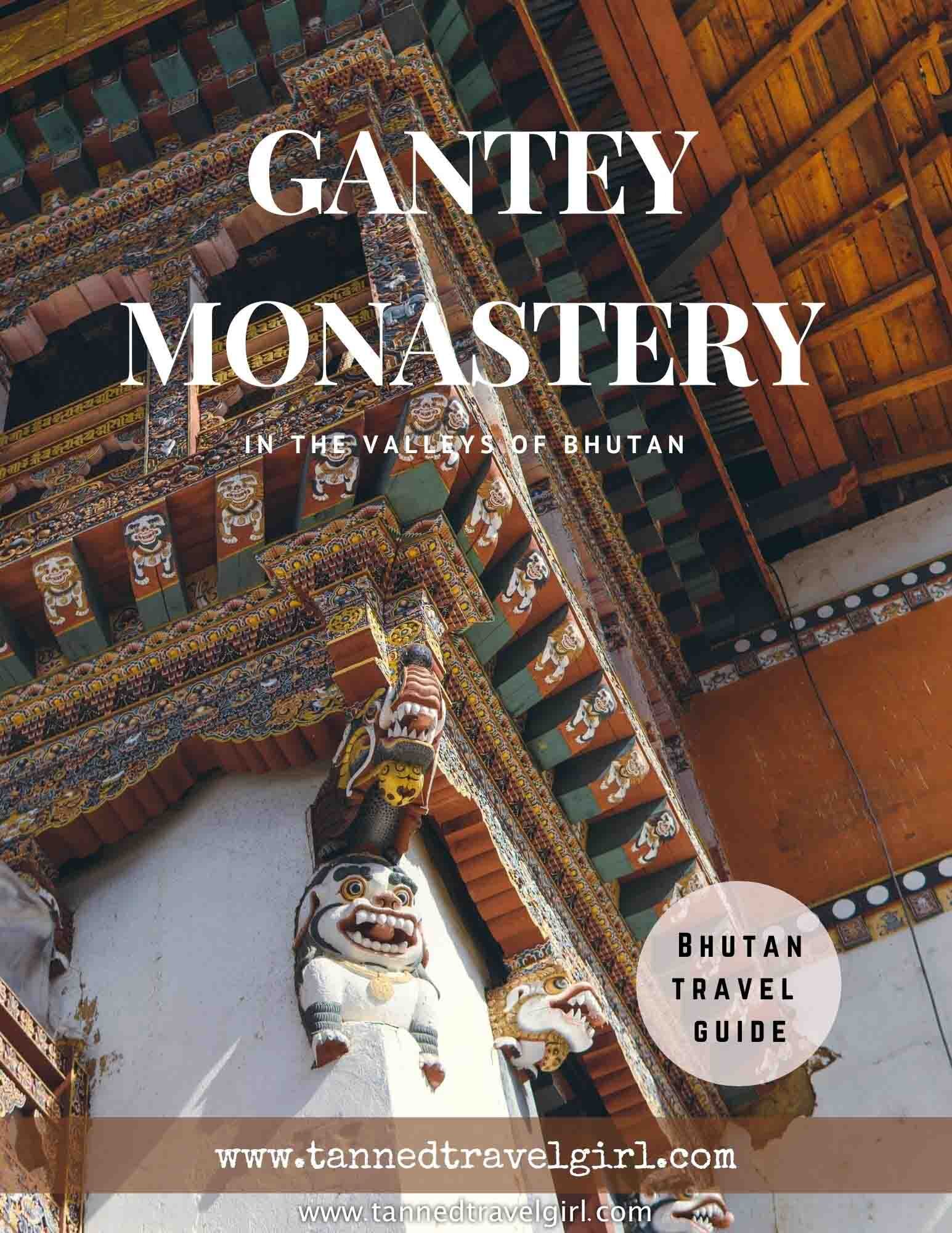Gangtey Monastery in the beautiful Phobjikha Valley of Bhutan - Travel Guide
Perched on the mountain top of Bhutan’s most scenic and picturesque valley, Gangtey Monastery is one of the most important monasteries in Bhutan.
It was Day 3 of my Bhutan trip and after visiting the royal Punakha Dzong, I was already swamped by the centuries-old architectural brilliance of Bhutan. The next stop was Gangtey Monastery (also known as Gangtey Goempa). After a wholesome breakfast cooked by our lovely host Kinley’s mother, we bid Goodbye to Kinley and family and started our 2 hours journey towards Gangtey Monastery.
Impressed by the majestic mountains of Phobjikha Valley, Pema Lingpa (a Bhutanese saint who is considered as the reincarnation of Guru Rinpoche) had foretold the construction of a monastery in the 15th century. This prediction fructified when a monastery was built in 1613 in Phobjikha. As I hear the stories of monasteries and Lhakhangs from our guide, my mind transported me to centuries-old Bhutan to relive the history I had read before coming to Bhutan.
Gangtey Monastery built using timber wood, native stones and painted with colours from minerals multi-folded my love and admiration for Bhutan’s well-kept monasteries. The experience inside the Gangtey monastery is spiritual and will make you want to extend your stay in Bhutan to untangle the mysteries of the past.
In this blog, I have tried to cover everything which will make you want to add Gangtey Monastery to your Bhutan itinerary. Hope you find it useful. Happy reading!
Quick Navigation for Gangtey Monastery Blog
Gangtey Monastery History
Gangtey Monastery Architecture
Gangtey Monastery Timings and Entry Fees
Gangtey Monastery Festivals
Other Attractions near Gangtey Monastery
How to reach Gangtey Monastery
Best time to visit Gangtey Monastery
Permit requirement for visiting Gangtey Monastery
Places to Stay near Gangtey Monastery
Places to Eat near Gangtey Monastery
Tips for visiting the Gangtey Monastery ( Must Read )
Gangtey Monastery History
Padmasambhava (also known as Guru Rinpoche) is considered as the Second Buddha in Bhutan. Padmasambhava and his principal consorts and disciples secreted away and hid religious texts, ritual objects and relics etc (called Terma) to secure and protect Buddhism during the time of decline (in 8th and 9th century).
The Nyingma tradition is the oldest of the four major schools of Tibetan Buddhism and Pema Lingpa is the second most important saint/ guru in Nyingma tradition after Guru Rinpoche because of his role in spreading Buddism in Bhutan.
Padmasambhava appeared before Pema Lingpa and had placed in his hands an inventory of one hundred and eight major termas to be revealed. Pema Lingpa was able to reveal the majority of the Termas. There are many profound stories about Pema Lingpa. One is that he jumped in a lake with a burning butter lamp and emerged back from the water with a treasure in one hand and the butter lamp still burning in the other hand.
Pema Lingpa had come on a visit to the Phobjikha Valley as a saint to teach Buddhism to the people in the valley and also to bless them. During this visit, after looking at the impressive mountains that surrounded the valley he had foretold that one of his descendants would build a monastery on the top of the mountain and make it famous as the seat of the Peling tradition.
This prediction fructified when Gangtey Monastery was built by his grandson, Gyalse Pema Thinley, in 1613. Now it is the main seat of Pema Lingpa tradition.
Interesting fact - The current kings of Bhutan are from the Wangchuck Dynasty and they are also descendants of Pema Lingpa.
Gangtey Monastery Architecture
4 storey Gangtey Monastery is in the middle of a huge complex and surrounded by monks’ living quarters and prayer rooms. The monastery is built in traditional Tibetian architectural style using large timber wood pillars. The walls are white with colourful windows.
The lower part of the wall has golden prayer wheels fixed between beautifully painted frames. Locals circumambulate around the monastery rotating the prayer wheel and enchanting the prayers.
The upper part of the monastery is built with Timber wood which is painted using colours from natural minerals. Intricate designs primarily reflecting religious stories from the past are painted/ carved on the wood. Each corner of the monastery has dragons, garudas and other protective figures inbuilt. The structure of the monastery gives an auspicious and spiritual aura to the entire space. Major restoration work was done for the monastery to protect the past legacy for the future. The restoration took 8 years to complete and 700 million Nu (USD 10 million).
Inside the monastery, there are beautiful statues of Rinpoche and other deities at each level. You will see butter lamps lit, monks performing prayers and special ceremonies. The fragrance from the incense stick like that of pure herbs from the Himalayas and the mysterious ambience inside the monastery will transport you to an unknown hidden world in the mountains.
Gangtey Monastery Timings and Entry Fees
The opening hours for Gangtey Monastery is from morning 6 AM till 5:00 PM.
There are no entry charges for visiting Gangtey Monastery.
Gangtey Monastery Festivals
The Black Necked Crane Festival
Black-necked cranes, the only alpine crane species in the world, travel from their summer breeding grounds on the Tibetan Plateau to picturesque Phobjikha valley. On arrival in Phobhjikha Valley, they circle Gangteng Monastery three times as if practising circumambulation, and then repeat this action as they return to Tibet in early spring. The black-necked crane is considered a sacred bird in Bhutan, revered as a symbol of longevity. The Black-necked Crane Festival is celebrated during mid-November every year and draws an increasing number of travellers to the valley each year.
Gangtey Tshechu Festival
Tshechu is an annual religious Bhutanese festival held in each district of Bhutan. Tshechu is celebrated to commemorate the Guru Rinpoche's Birth who is known as the Second Buddha across the nation. During the Gangtey Tshechu, there is a colourful showcase of life and culture, whereby various mask dances and traditional performances are done by monks. The dance is called the Cham dance.
Photos of monks living in Gangtey Monastery
Other Attractions near Gangtey Monastery
Gangtey Nature Trail
Gangtey Nature Trail is around an hour and a half downhill hike starting from the Gangtey Monastery passing through the pine cone forests, Semchubara village, open valley and ending to Khewang Lhakhang. The Gangtey Nature Trail hike is easy and will offer picturesque views of the valley.
Phobjika Valley
When I was planning for my Bhutan trip, I was told that Phobjikha valley is the most beautiful valley in Bhutan. I thought it to be praise from an enchanted traveller and planned a night stay in the valley for exploring Gangtey Monastery and the other things nearby. When I first saw the vast wetlands of the valley surrounded by mountains with beautiful houses scattered on them, I felt I was magically transported to a hidden valley in the Himalayas.
Black craned centre
For the protection of the endangered species, the kingdom has set up Royal Society for Protection of Nature (RSPN). RSPN in the valley looks after the protection of the cranes and also spread awareness amongst the locals on the same. At the centre, they have a spotting area with powerful telescopes to help you see the cranes roosting in the valley. The entry fee for the Black craned centre is nominal (Nu 100) and the centre is open from 9 AM to 5 PM.
Gangtey Nature Trail hike in Phobjikha valley in Bhutan
Black-necked crane information centre in bhutan
How to reach Gangtey Monastery
There is no airport near Gangtey Monastery. The only international airport in Bhutan is in Paro with a limited number of flights to and from specific countries. The only way to reach Gangtey Monastery is by road.
Punakha to Gangtey Monastery -
Gangtey Monastery is 80 km from Punakha Dzong and will take around 2 hours to reach. The best way and possibly the only way to reach Gangtey Monastery from Punakha Dzong is through a private taxi. There is no direct buses/ public transport between Punakha to Gantey Monastery.
Thimphu to Gangtey Monastery -
Gangtey Monastery is 125 km from Thimphu and will take around 4 hours by road. There are limited buses between Thimphu and Phobjikha Valley on specific days (Thursday and Saturday) with limited capacity. The easiest and most convenient way to reach Gangtey Monastery is by a private taxi.
Paro to Gangtey Monastery -
Gangtey Monastery is 170 km from Paro and will take around 5 hours by road. There are no direct buses between Gangtey Monastery and Paro.
IMPORTANT NOTE - If you are visiting Bhutan by paying the Tourism levy of USD 250 (summer)/ USD 200 (winter), there will be a private taxi and a guide arranged for you and you don’t need to worry about the commute. Just speak with your tour manager and ask them to add Gangtey Monastery to your itinerary. This part is more relevant for people travelling to Bhutan on their own without a tour guide (possible only for passport holders from India, Bangladesh and Maldives).
Best time to visit Gangtey Monastery
Usually, March to May (Spring Season) and September till November (Autumn season) are the best months to visit Bhutan overall. If you are into bird watching, Late October to Early February will be the best time for visiting Gangtey Monastery because, during these months, the black-necked cranes migrate from Tibet to Bhutan.
If you also want to enjoy the local festivities, you should plan your trip to Gangtey Monastery in mid of November during the Black-necked festival time or the Gangtey Tshechu Festival. Late December till early February is really cold and temperature could fall below -5 in this part of Bhutan.
Permit requirement for visiting Gangtey Monastery
For Passport holders from India, Bangladesh and Maldives - You will need a special permit to visit beyond Thimphu and Paro. Gangtey Monastery is in Wangdue Phordong District in Bhutan for which you will need a special permit. The special permit needs to be applied from the immigration office in Thimphu.
For passport holders from other Countries - If you are from other countries, you do not need a special permit. All the pass requirements will be taken care of by your tour operators. Just ask them to add Gangtey Monastery in your itinerary.
Places to Stay near Gangtey Monastery
There are a few places just minutes away from Gangtey Monastery. Usually, travellers and tourist stay in Phobjikha Valley and come to Gangtey Monastery trekking through Gangtey Nature Trail. Giving some options for stay for visiting Gangtey Monastery
Budget stay - Thegchen Phodrang Lodge, Pema Choden Homestay, Gakiling Guest House, Phunutshocholing Farm House
Medium priced - Dewachan Hotel
Luxury Stay - Gangtey Lodge Bhutan, Amankora Gangtey, Kichu Resort, Six Senses Phobjika
I had stayed with Dewachan which is in Phobjikha valley. The hotel is at quite a nice location with a beautiful view of the valley. The rooms were comfortable and the staff was nice too.
Places to Eat near Gangtey Monastery
There are no touristy hotels/ restaurants near Gangtey except one or two small restaurants. You can find small shops selling local snack dishes like momos and meat with spices.
It will be better to carry your meals along if you are on a day tour to Gangtey Monastery. If you are staying in Phobjikha, the better option will be to eat in your hotel.
Tips for visiting the Gangtey Monastery
Clothing for Gangtey Monastery - I recommend modest clothing while visiting the Gangtey Monastery. Wear clothing covering at least till your knees. Otherwise, it will be regarded as disrespect to the deity and you will not be allowed to enter inside the monastery. If you visit the Monastery in the winters, wear the warmest jacket you own. The monastery will feel like an ice chamber from inside.
You will need to remove shoes before entering the main temple. Also, photography is not allowed inside the temple.
Do not talk loudly inside the main temple as it is regarded as inappropriate in the culture.
Gangtey Monastery is also a home for monks. Respect their personal space and ask before taking their pictures, some of them don’t like it and some are extremely friendly.
There are a few small shops selling souvenirs outside the temple. The prices of which are a bit on a higher side when compared to the prices in the Cities (Paro/ Thimphu).
There are no ATMs near the temple. Also, carry enough cash because cards would hardly be accepted here other than at good hotels.
Bhutan has history and tantric Buddhism mysteries hidden in each nook and corners. Monks and locals at Gangtey Monastery are not so well versed with other languages and would only be able to share the details better in their local language. To understand the religious and spiritual aspects of Bhutan, I will highly recommend you to hire a tour guide for your Bhutan trip.
I hope you found this Gangtey Monastery blog helpful in planning your Bhutan trip. If you have any more questions, drop them in the comments and I will revert soon.
I would also recommend you to add Bhumtang, the most spiritual centre of Bhutan, to your Bhutan travel itinerary. I have covered some of the lesser-explored monasteries, towns and unseen sides of Bhutan to help you plan a perfect non-conventional itinerary for your Bhutan trip. Read my blogs on Bhutan down below.
Love,
Tanned Travel Girl























